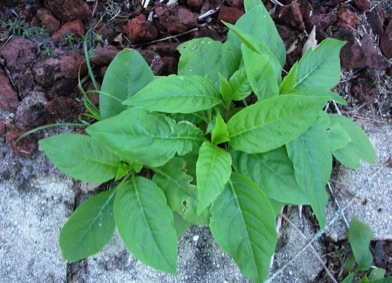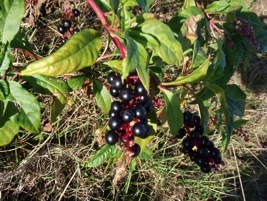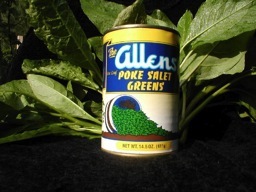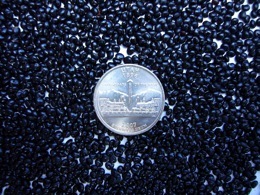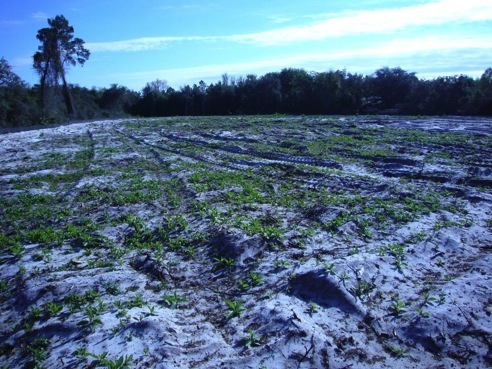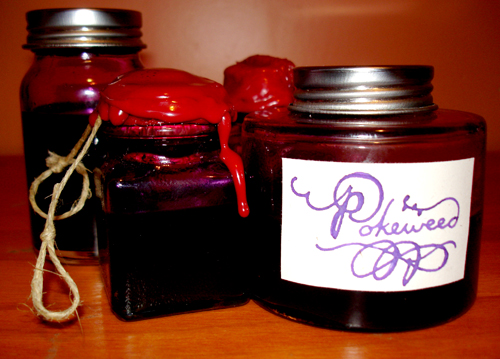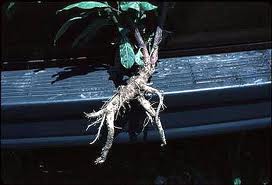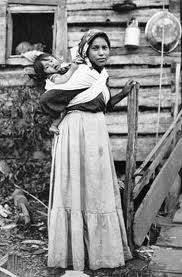Can Be Deadly But Oh So MildyDelicious: Poke weed
Poke weed will challenge your commitment to foraging.
It is not the most commonly eaten food from a poisonous source. Tapioca or cashews would probably take that prize. But poke weed’s in the running. If prepared incorrectly or carelessly it can make you quite ill, or worse, put a ‘k’ in front of ill as in kill you. But when picked and prepared properly, as millions have done over the centuries, it is perhaps the most delicious pot herb of all, one that makes you look forward to next season.
Phytolacca americana (fy-toe-LAK-ah am-er-i-KAY-na) is native to the eastern United States. Americana means of America. Phytolacca is an international construct combining phyton (Greek for plant) and Lac (French for a dark red pigment.) The word “poke” comes from the Virginia Algonquian (Native American) word “pakon” or “pucone” first recorded in 1708. Pakon refers to a plant used for dye or staining, and indeed a red coloring from the poke weed’s berries has been used as a dye for centuries. Natives used the juice to color feathers, arrow shafts, garments, even their horses. Berry juice was also used at one time to color wine, but that practice was made illegal. In a modern twist, red dye from poke berries doubles the efficiency of certain solar cells.
While coloring foods with poke berry juice has been banned, because it is reportedly poisonous, Dr. Julia Morton says on page 51 of her “Wild Plants for Survival In South Florida” 1982 edition, “The strained juice of ripe fruits may be safely used for coloring foods.” During her lifetime, Professor Morton was the most authoritative source in Florida on toxic plants and her works still the main references. In theory the juice could be made into jelly. While the berries are the least poisonous part of the plant, never eat the seeds or the root. Accidental poisoning have happened by people getting a little root with the shoot. And never eat a mature poke weed. What’s mature? For safety, I would consider any poke weed over 7 inches mature and off limits. And, or, any poke weed with deep red stems no matter how short it is.
Poke weed grew a good reputation centuries ago despite its dangerous side because it’s one of the first mild edible greens in spring, at a time when folks have been living on non-greens for several winter months or peppery members of the mustard family. Many attempts were made to move the weed into the mainstream vegetable market — as it is in parts of Europe — but it just never took off in North America. However, the demand for it was enough to keep two companies canning it up into the 1990’s. That southern tradition ended in the spring of 2000. In April that year the Allen Canning Company of Siloam Springs, Arkansas, canned its last batch of poke sallet. The reason why they stopped canning poke weed was there were not enough people interested in picking it for them. So, if you want poke weed you really do have to pick it yourself or order it through botique stores on line
A third alternative I’ve heard of which I haven’t tried because I live in Florida — where houses don’t have basements — is dig up a poke weed root and bury it in a sand box in a lightless area of your basement. In the spring it will send out white shoots which some say only need to be boiled once. While that may be theoretically possible, it would take a lot of roots to get enough shoots for even one meal. You’re better off harvesting it or collecting the seeds and growing your own. More on that in a moment.
When I go collecting poke weed, I take a ruler with me. It’s called my hand. From the tip of my middle finger to my wrist is about six inches. If the shoot is six inches or under, into the pot it will go, taller I leave it be. The second rule is pick nothing with red stems but that’s not so hard and fast because even two-inch shoots can sometimes be pink to red. And when I gather it I don’t pull it up, I cut it to avoid the possibility of getting any root. And do not handle raw poke weed if you have any cuts or abrasion on your hands. It has mitogens which I will explain later.
The top picture of young poke weed is the appropriate size range. While I boil them twice. First time one minute. Then I change the water and boil for 15 minutes. That said, I know a southerner who not only picks red-stemmed shoots but boils them only once. That’s too brave for me but as of this writing she’s 70 and her husband 85 and they’ve been doing that every spring since they were kids in Kentucky. Merritt Fernald in Edible Plants of Eastern North America (1958 edition) writes young shoots need only to be boiled once. He also says they make great pickles.Unboiled poke leaves when eaten dissolve the mucus that protects your stomach et cetera from the hydrochloric acid there thus you begin to painfully digests yourself.
I like the 1/15 boiling method because it accommodates large quantities of poke weed. You can boil them for a minute and then freeze. Mark the package that it has to be boil 15 minutes after thawing. The 1/15 also helps with cooking large amounts of poke weed. Use two pots of boiling water: One pot should be the right size for cooking your poke weed and the other should be much larger. The larger pot is your reservoir of boiling water. When both pots are at a boil, drop the poke weed into the smaller pot with ample water and boil them for one minute. Throw away this first water then refill the cooking pot with fresh boiling water from the large pot and boil for a minimum of 15 minutes and enjoy. I have tried this and it seems to works well. I’m still here. If you want to feel safer about it boil them twice in one minute baths and then boil 15 minutes. (I know how you feel. Long ago I used to cook poke weed in boiling water three times, 20 minutes each. Then I dropped down to two 30 minute boils, then two 20 minute boils. I heard of the 1/1/15 method and used it successfully. Then inadvertently I did 1/15. Been doing that ever since. Then again, I’m not a detail person so that one minute is usually longer, so is the 15. )
A few folks also peel the stalks fry them like okra. Some blanch them first, others do not. Seedless berries reportedly can be made into pies but before I do that I’d like to meet someone alive who has done that, eaten said, and is still among us. Read don’t do it because it was supposedly done. It would also take a fine mesh to separate the seeds from the berries, but not impossible. Also, if you are thinking about raising poke weed from seeds, they are resilient. The best germination comes after fermenting the berries then soaking the dried seeds in sulfuric acid (battery acid) for five minutes then washing thoroughly. That probably replicates conditions in a bird’s gut. I tried that this last year and it worked very well with a full row of poke weed in my garden.
I like poke weed shoots just fine boiled then dressed up with salt, pepper and butter, or olive oil. Best guess: Boil it at least twice for insurance if not three times for assurance. I’ve come to prefer the one-fifteen method particularly for young poke. Older poke might need more boiling. Some day, when you are an experienced poke picker, you can make up your own rules. Nutritionally, poke weed is a powerhouse: A half cup of the greens provides 35 calories (10 from fat), no cholesterol, three grams dietary fiber, and 90% of your daily need for vitamin A, 60% of vitamin C, 8% calcium, and 6% of iron. Poke weed has 8,700 IU’s of vitamin A per 100g serving. Vitamin A as Beta Carotene is not water solable so boiling does not significantly reduce it.
Incidentally, you will hear poke weed called “poke sallet” which sounds like “salad.” That “sallet” and “salad” sound the same today has been the cause of a few poisonings because people did not cook the poke weed before eating it. Never eat poke weed raw. NEVER. Always cook it. I know of someone who accidentally ate raw poke weed leaves and was wretchedly ill. Some web sites say “Sallet” is an old English word meaning “cooked greens” but research does not bear that out. “Sallet herbs” were eaten raw and “pot herbs” cooked. “Poke sallet” is just a time-corrupted use of the term. Sometimes “sallet” is spelt “salet” but that’s not only incorrect but a “salet” is a helmet from a few hundred years ago.
Doctors — and here I will admit my severe bias against them when it comes to food and nutrition issues — think the plant should be eradicated. This is the same group that told us transfats were good for us, and high fructose corn syrup. Not a good track record. There’s some evidence that compounds in poke weed are antiviral and it has potential against AIDS. More so, poke weed proteins have shown fantastic clinical results in the treatment of childhood leukemia. A study published in the Journal of Natural Products 5 Jan 2008 shows one saponin might have a positive effect on ovarian cancer. Not bad for a plant doctors want eliminated. However, to be balanced, there is evidence poke weed constituents — mitogens — have the potential to cause cell mutations. That is why you don’t handle it if you have cuts on your hands. Mitogens can stimulate the immune system and also cause cancer. That’s why we boil it. A precaution: Those pregnant should not eat it or handle it. That’s a lot of warnings, but it has also been eaten by millions for centuries.
Three historical notes: James Polk was a dark-horse candidate for president in the 1840’s. In one of the first PR gimmicks, his supporters wore poke leaves on their lapels. He became the 11th president of the United States. That’s Poke Power. And when the Constitution was written Tom Jefferson wrote it with ink made from poke berries on hemp paper… still legible after all these years. And during the US Civil War many a letter was written home with a bird feather and poke berry juice. These letters, too, are extant for us to read because an herb called poke weed was valued not eradicated.
To make ink remember those ripe berries you brought home to rot for the seeds. You crush the berries, strain out the seeds, and let the rest ferment for a couple of weeks. There is natural yeast on the berries or you can add a little wine or bread yeast. Then strain the liquid, once or twice depending on the thickness. You now have ink worthy of a constitution. You can mix fresh, filtered juice with vinegar to make a purple ink but it will fade. Fermenting turns the ink brown but sets it.
Lastly, I am doubtful about the presumed history of poke weed consumption. Poke weed certainly has been eaten for a few hundred years and that adds up to a lot of people. But I’m not sure about its use before the Europeans arrived in North America, that is, how the Native Americans used poke weed.
Consider: The Alabama Indians referred to Europeans as “those who eat poke weed.” That sounds as if the Alabama Indians did not. In fact, of the dozens of tribes we only know of four that used poke weed as a food, and those uses seem to break down into pre- and post metal pots. Also consider that boiling was a difficult task before the introduction of metal pots, particularly for a green that has far less nutrition than say a rat. I’ve got a suspicion that poke weed was medicinal (worth the difficulty of boiling) but not a food until it became easy to boil poke weed in changes of water in metal pots. In their different uses you can read pre- and post-metal pot use.
The Cherokee crushed the berries and sour grapes together, strained, mixed that with cornmeal and sugar to make a beverage. Leaves were gathered into a bundle and dried for future use. Those two uses do not require cooking. Crushed berries were used to add color to canned fruit. Young shoots, leaves and stems were parboiled, rinsed, and cooked alone or mixed with other greens and eggs. Peeled stalks cut lengthwise, parboiled, dipped in egg, rolled in cornmeal, fried like fish. Those require cooking. The Iroquopis, Malecite and Mohegans also ate poke but how was not recorded. That’s not a lot of ethnobotanical evidence that native were eating a lot of poke weed long before Europe discovered America. I personally know two people who swallow one berry whole (no chewing) to treat arthritis. Other than personal testimony I have no idea if it works or not. As I say Herbalism is outside my pay grade.
Green Deane’s “Itemized” Plant Profile: Pokeweed
IDENTIFICATION: Phytolacca americana: (See “Telling The Difference” below) Poke weed is rugged but not handsome. It’s four to ten feet tall, stout with reddish stems, leaves four to 10 inches long. The plant often has a scraggly look. It’s flowers can be green, white or pink on a stalk six to eight inches long. The berries are globular, purple black, flattened on top and bottom. The root is so toxic if you handle it do so with gloves.
TIME OF YEAR: Blossoms primarily in spring but can blossom all year until interrupted by frost or winter.
ENVIRONMENT: Poke weeds are opportunists, disturbed land often produces huge amounts, but likes rich, moist soil.
METHOD OF PREPARATION: Never eat poke weed shoots uncooked. They can make you very sick. Never get any part of the root in with your greens. That can kill you. Boil short, young shoots at least twice, changing the water both times. Many writer recommend boiling them three times, which is acceptable, too. It does not change the flavor though drain your cooked greens well, they absorb a lot of water. Poke berries, minus the seeds, have been mixed with grapes, sugar and cornmeal and fermented.
HERB BLURB
Foxfire II said hill people believed a home-made antidote for eating raw poke weed was drinking lots of vinegar and eating a pound of lard.
Telling the difference
Inkweed (Phytolacca octandra) is very similar to American pokeweed (Phytolacca americana) and Venezuelan pokeweed (Phytolacca rivinoides). These species can be distinguished by the following differences:
• inkweed (Phytolacca octandra) flowers are borne on very short stalks (i.e. pedicels) only 2-3 mm long and usually have 7-8 stamens. Their ‘petals’ (i.e. tepals or perianth segments) turn red and persist on the developing fruit. The mature fruit are relatively small (4-6 mm across) and usually have eight slight lobes (i.e. they usually contain eight seeds).
• American pokeweed (Phytolacca americana) flowers are borne on relatively long stalks (i.e. pedicels) 5-10 mm long and usually have 10-11 stamens. Their ‘petals’ (i.e. tepals or perianth segments) turn red and persist on the developing fruit. The mature fruit are relatively large (5-11 mm across) and have ten or eleven slight lobes (i.e. they contain ten or eleven seeds).
• Venezuelan pokeweed (Phytolacca rivinoides) flowers are borne on relatively long stalks (i.e. pedicels) 7-12 mm long and have 9-14 stamens. Their ‘petals’ (i.e. tepals or perianth segments) fall off as the fruit begin to mature. The mature fruit are relatively small (5-6 mm across) and have 12-16 slight lobes (i.e. they contain 12-16 seeds).

